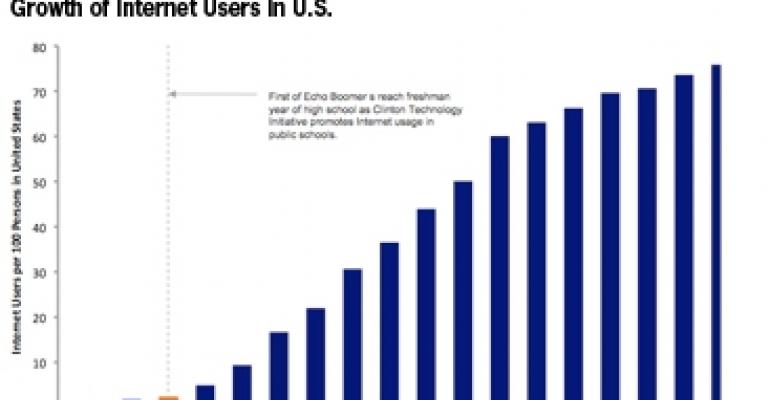The introduction of the Internet, e-commerce and other online platforms has undeniably caused a revolution in the retail world. Consumers’ comfort and savvy with the Internet has increased dramatically over the last decade. The percentage of people identifying themselves as Internet users increased from roughly half of the U.S. population in 2000 to approximately 80% in 2008.
It is notable that right on the cusp of this phenomenon is the enormous population wave of Echo Boomers, a cohort approximately equal in size to the Baby Boomers. These were the first young people to have access to computers, Internet and mobile communications technology throughout high school, which clearly has had a significant impact on their shopping behavior.

A revolution, not evolution
Perhaps even more significant than the number of people described as “Internet users” is the introduction of high-speed Internet access in homes and offices, which effectively ushered in the era of online shopping. Broadband, digital subscriber line (DSL) and other forms of high-speed service have enabled the Internet to become an effective retailing channel.
In 2002, 10% to 20% of U.S. households in the 10 largest metropolitan statistical areas (MSAs) used broadband at home. By 2007, 50% to 80% of households were using broadband at home. This trend represents a sea change in the number of people with the means to efficiently shop online at home. These customers also have a virtually instant and unlimited source of product and pricing information, and exponentially greater buying options.
With the growth of broadband access, e-commerce has naturally taken a greater share of overall retail. E-commerce sales have increased every year since the beginning of the decade with an average growth of 20% per year since 2001, creating a $143 billion industry in 2009.
Despite this growth, e-commerce accounts for only 4.2% of the total retail industry as of the third quarter of 2010, according to the U.S. Census Bureau.

The effect of e-commerce varies by retail category. Discretionary and fungible goods have seen the most cannibalism of market share from e-commerce. Goods such as books, music, clothing and electronics appear especially susceptible to competition from online retailers.
However, we find that when incomes, employment, and population are held constant, the relative amount of broadband usage in an MSA correlates strongly and positively with physical store sales. In other words, based on the data, the Internet surprisingly appears to support brick-and-mortar retail.
Essentially, the availability of pricing and product information via the Internet does two important things: it reduces “search costs” and increases the interaction around purchasing goods. If a consumer can quickly comparison shop online, the amount of time required for brick-and-mortar shopping decreases.
Traditional retail theory dictates that as the duration of time required for a shopping trip decreases, the frequency of shopping trips will increase. Consumers still want to see and feel many of the products they buy; they also want to interact with the seller.
Many retailers have observed that most of their customers comparison shop online before purchasing a product in the store. Consumers often want service as well as the ability to return products to the physical store.
Complementary tool
The Internet has become a supplemental tool for savvy retailers. Many retailers are successfully incorporating their own websites into multi-channel strategies by offering multiple means for a consumer to obtain a particular good. Although retailers may face execution challenges, multi-channel retailing can effectively increase overall profitability.
Retailers also use their online platforms to create stronger brand identity and create an online community that follows and discusses their products. Online marketing and e-mail lists give retailers the ability to more effectively advertise and inform their customers.
Finally, retailers can garner more detailed information about who their customers are and what they want from online sales and website trackers known as cookies. This tracking capability translates into better product design, pricing and inventory management in physical stores.
The development of a multi-channel platform benefits both retailers and consumers. Retailers gain enhanced customer loyalty, better customer profiling and a more thorough knowledge of consumer preferences.
Logistically, retailers are able to more efficiently streamline distribution systems and inventory management while gaining a secondary source of revenue. Consumers gain more convenient shopping experiences, brand identity, and additional product and price awareness.
While the Internet is having a sweeping effect on retailing, the immediate impact on supply-chain strategies is subtle. The technology enables retailers to maintain smaller inventories and more efficient stores, but this does not directly equate to smaller floorplates and less real estate.
In general, we expect the effect of the Internet on retail real estate to be either limited or helpful to brick-and-mortar retail in the near term. The long-term effect is unclear, although it is likely to result in creative new store formats as brick-and-mortar retailers incorporate their online platforms and try to enhance the “store experience.”
To date, the Internet presents more opportunities than drawbacks for brick-and-mortar retailers. Multi-channel retailing has translated into more effective retail business models and will be a vital part of retail strategy going forward.

David Lynn is a managing director, generalist portfolio manager and head of investment strategy for ING Clarion Partners in New York.

